Thinking about Fuerteventura now, this is what I cherish the most. Because it was absolutely amazing and the one thing I had really looked forward to. Going whale and dolphin watching in the Canary Islands and seeing dolphins in their natural environment! See dolphins, we did. The whales were a bit more elusive. We did not book a tour before the trip, as we thought of finding out more once we were there. It was off-season in spring, so there was no worry of tours being fully-booked.
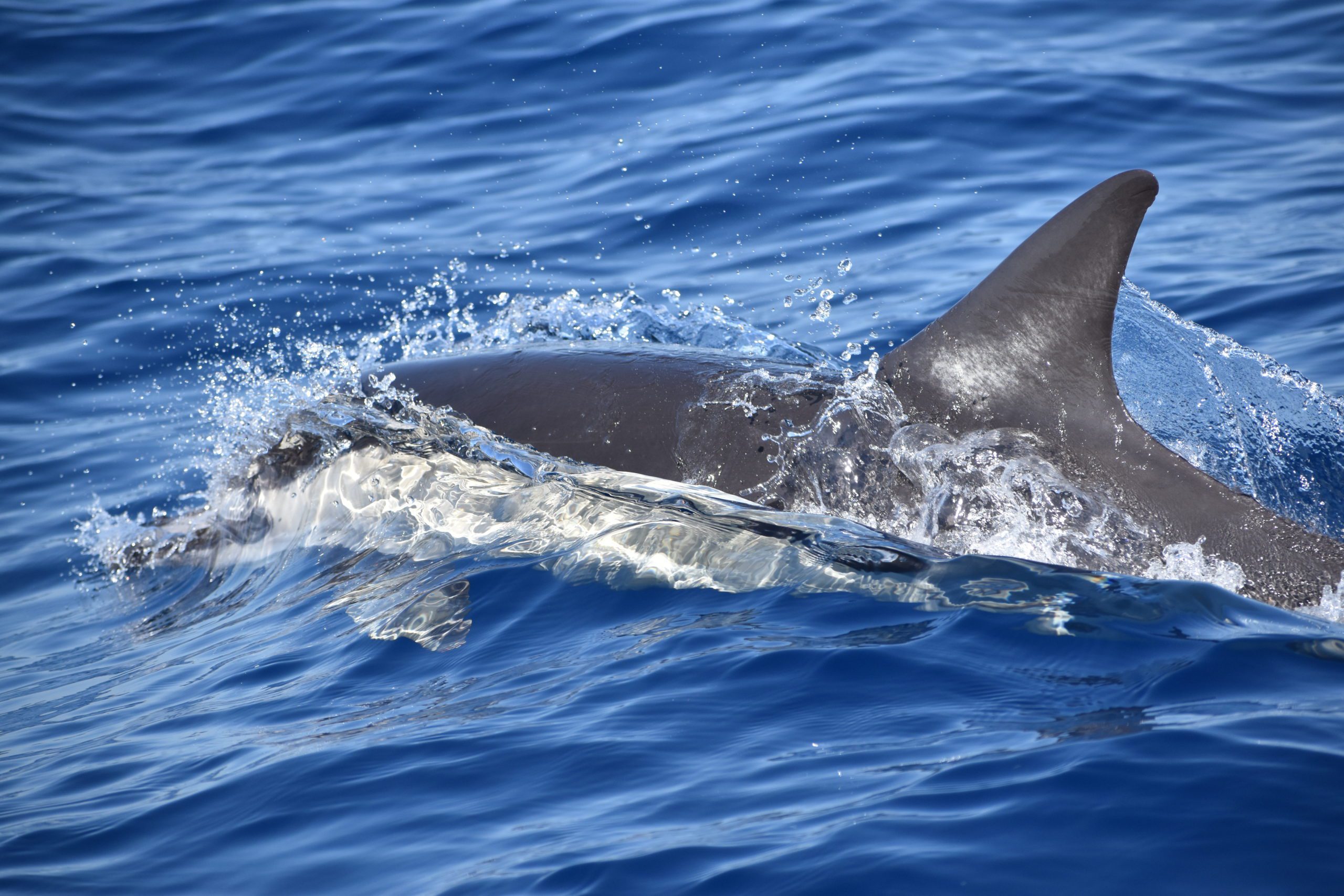
I read a guide beforehand (The Best Whale Watching in Europe by Erich Hoyt, Whale and Dolphin Conservation Society) to have an idea what to expect, and learn about the species of cetaceans we could possibly see. The Canary Islands are one of the few places in the world where whale watching is possible year-round.
The warm waters attract many species, and it’s also the permanent residence of some dolphins and whales. Book a tour with a naturalist if you want to learn more about the marine environment and species.
Booking the tour
On our second day in Fuerteventura, we headed to the Morro Jable harbour in the south. We had searched for professional whale watching tours online as well and settled with Canco Fuerteventura.
Their website in English is clear and informative and they seem responsible: The do’s and don’t of watching the marine animals are clearly mentioned, and they are licensed ‘Blue Boat’ operators. There’s several dolphin watching tours to choose from, and we considered taking the tour from the northern part of the island.
CANCO Fuerteventura – Excursions and Sights*
We didn’t find one on that day at Morro Jable. Also, the tour from here was only 1.5 hours, whereas the one from Corralejo in the north was a 5-hour tour. This is worth the higher price (75 EUR per person) as it greatly increases our chances of spotting the animals and spending some time out in the sea.
We also considered potential spots for land-based dolphin watching. I had spotted an Indian Ocean humpback dolphin quite close to the shore in Kerala, India last year and it was quite a surprise. It’s actually not uncommon for dolphins to swim by the coast.
Finally, I booked the 5-hour Whale & Dolphin watching from Corralejo tour a couple of days later. The tour is offered on most days of the week in season, and you can contact them via WhatsApp for more information. We got a quick and clear response when we called them about the online booking.
The Experience
On the day of the tour, the weather was sunny with a bit of an early spring chill in the wind. A free pick-up was included in our area to the harbour. At about 9 AM, a minivan arrived near the entrance of our apartments and assuming it’s for us, we get in. There wasn’t a logo of the tour operator, so we just announced that we’re there for the dolphin tour. A couple of others were in too and according to the website, the tour is to have a maximum of 12 people.
We are greeted by our guide in a blue T-shirt at the harbour. The English spoken in Spain is usually some sort of attempt : ) so we are told in brief about the tour once we got onboard. Other than that, our guides didn’t say much, but were friendly. Heading out to the sea: it would take about an hour to get to a place where it’s likely the dolphins swim.
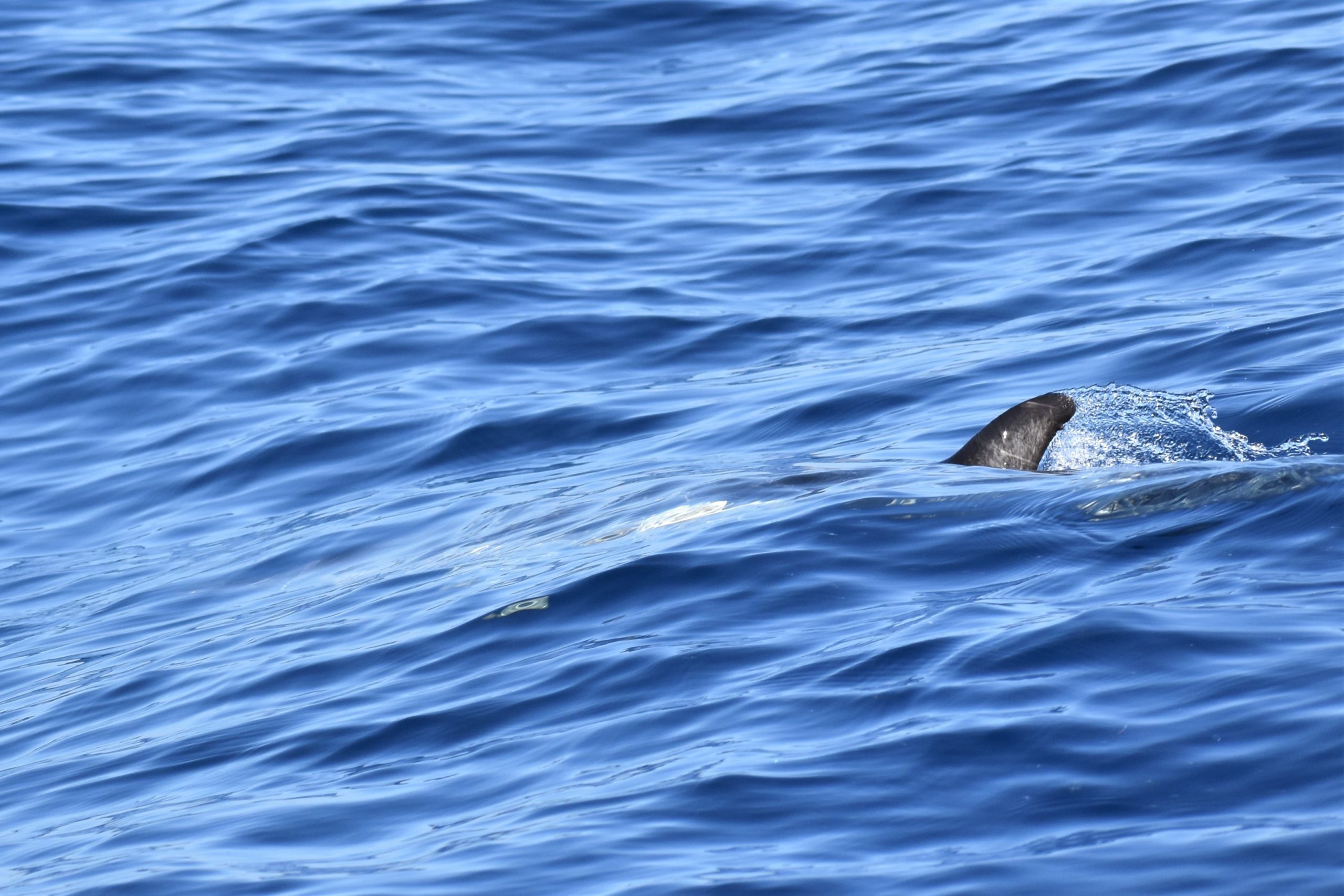
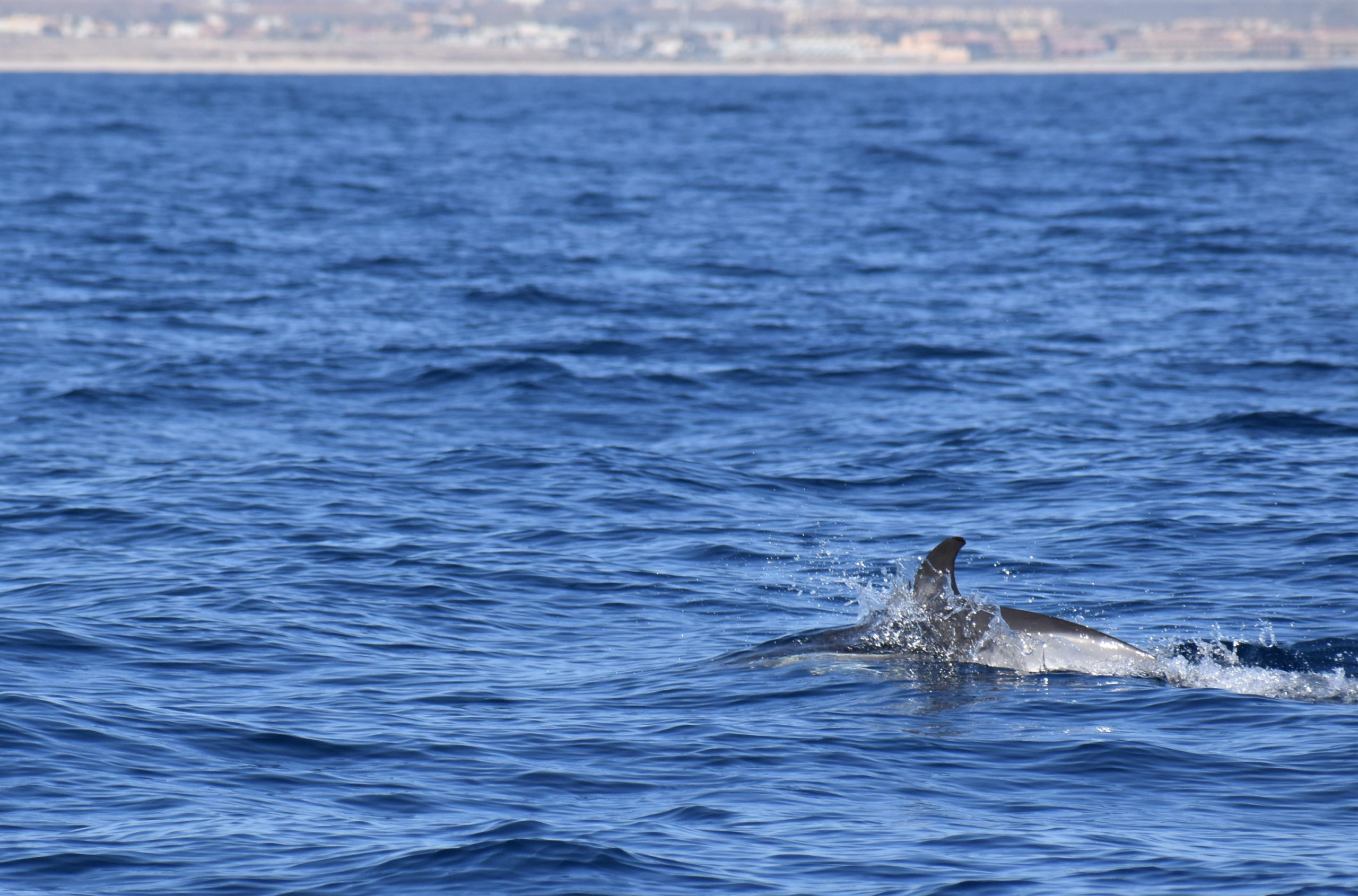
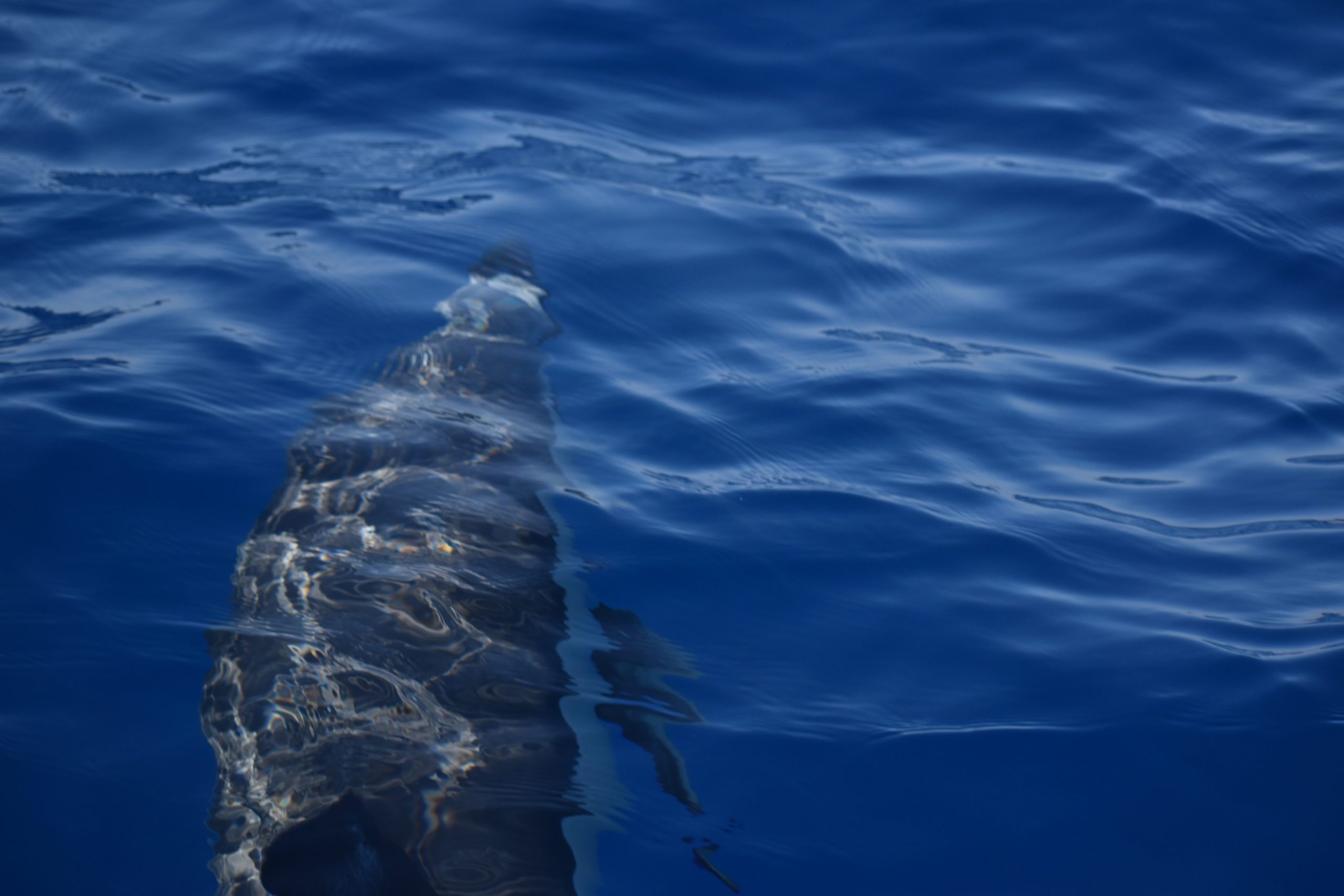
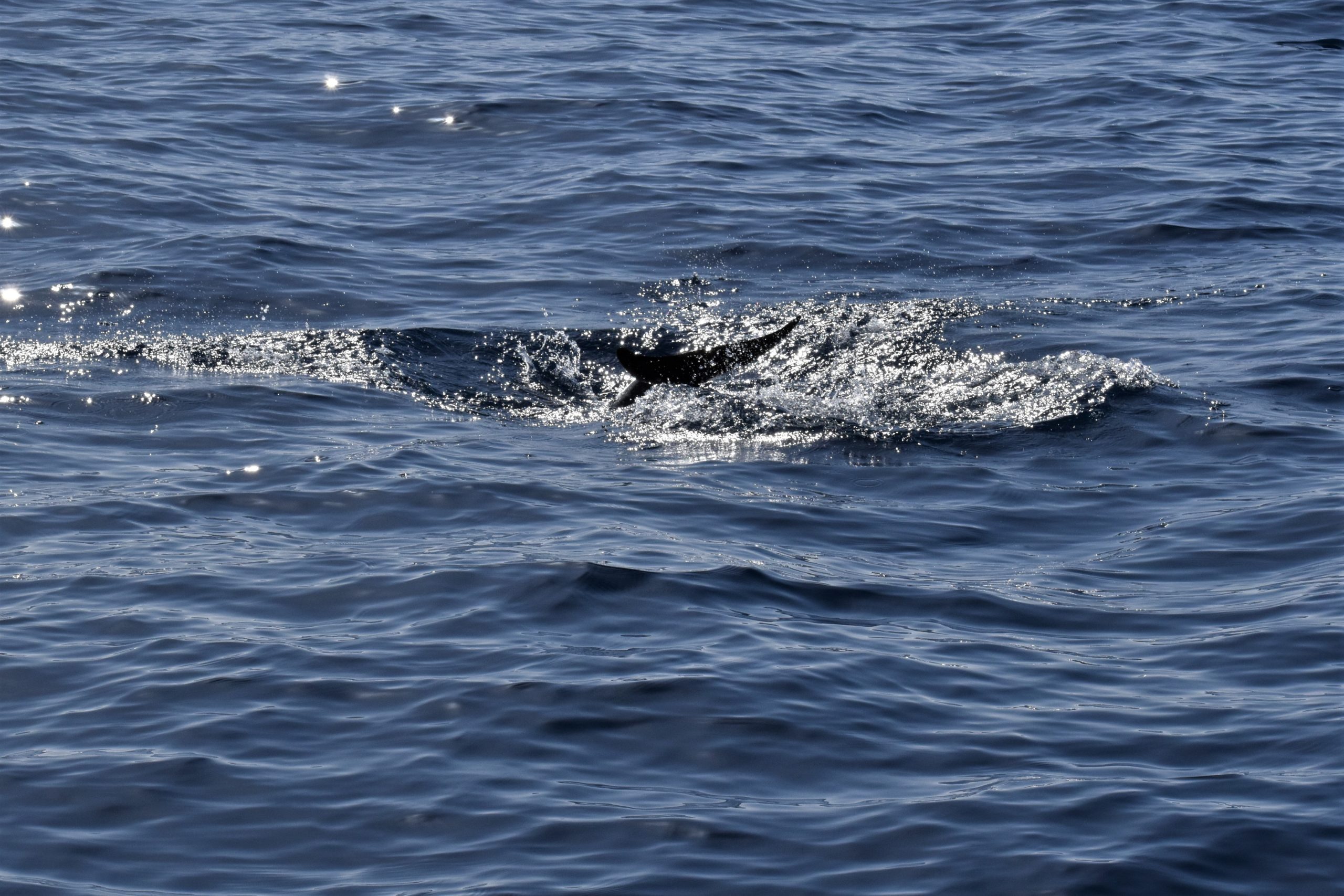
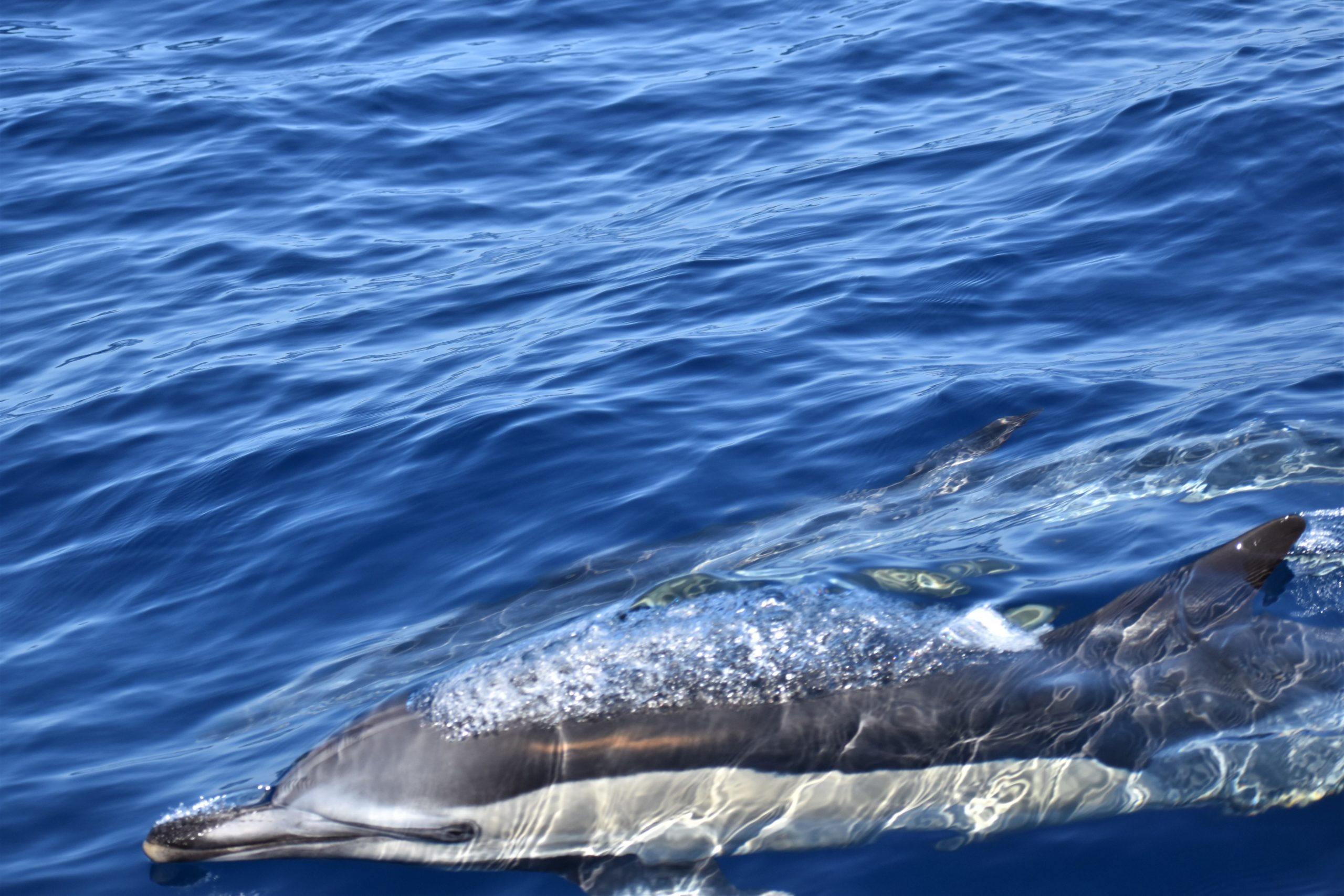
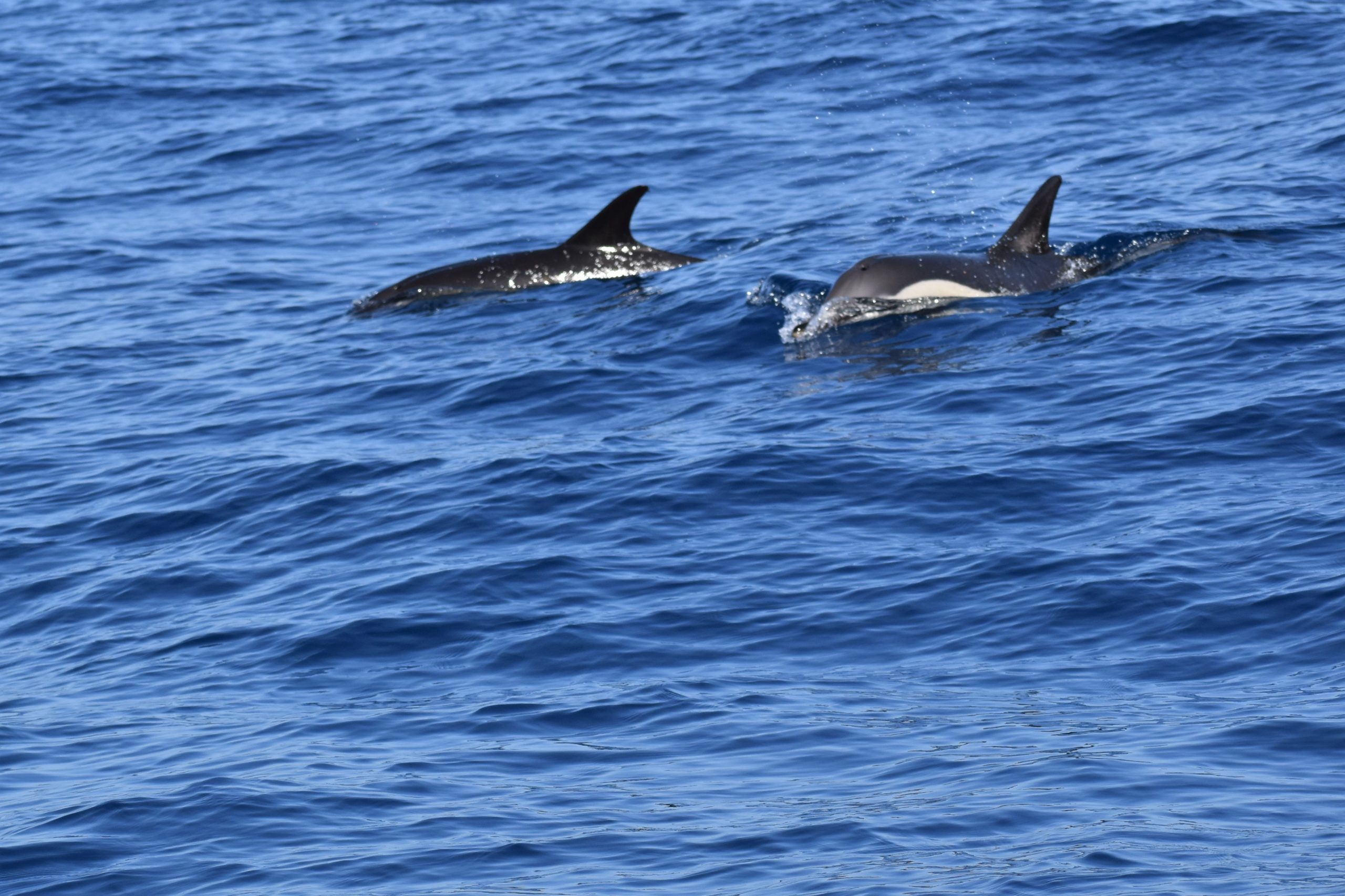
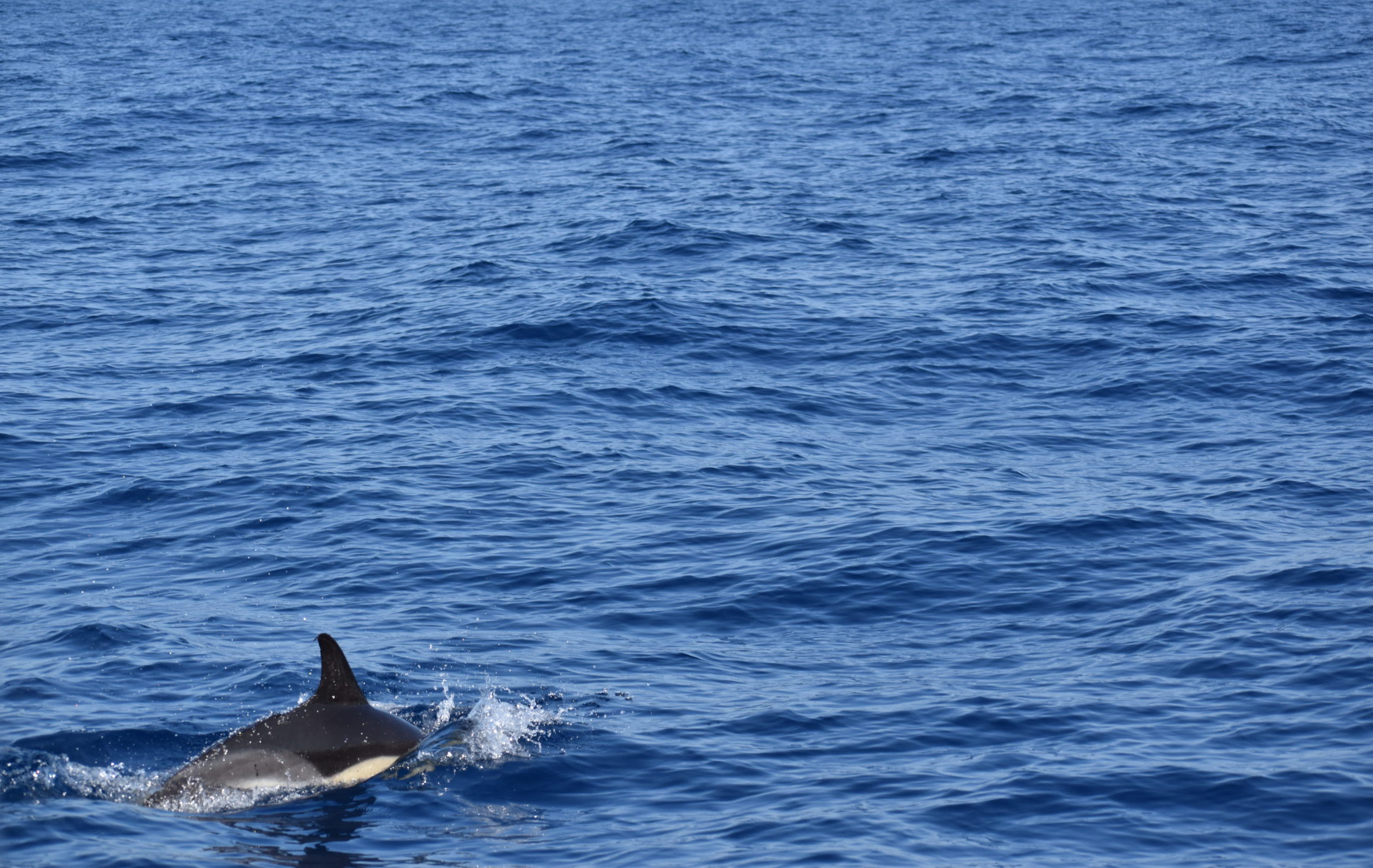
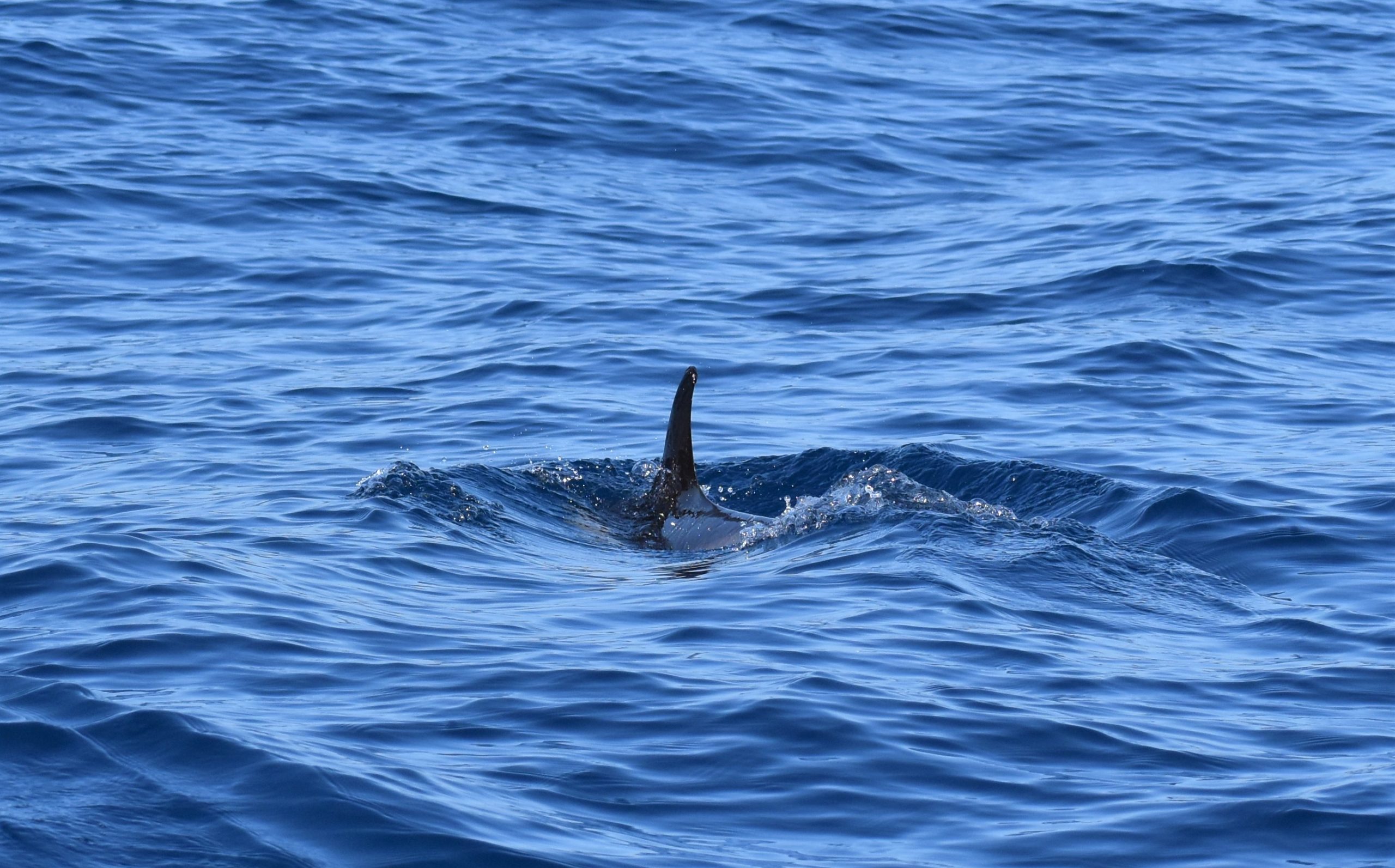
First glimpse
I hadn’t become desperate to see something yet. The captain alerted us that he’d spotted something and sure enough we see some flippers at the surface. I am more in a frenzy to click photographs at first than look around — it was the first time I photographed these marine creatures, and who knew whether they’d disappear in seconds or not.
Soon it is obvious that they like to swim by the boat as a couple were gracefully swimming under the bow. The water was clear and it’s the closest we saw them. This happened several times with the ‘short-beaked’ common dolphin (Delphinus delphis). It’s best seen in this clip I shot on the tour.
We are nearing the small island of Lobos. Here, a group of Atlantic bottlenose dolphins (Tursiops truncatus) show up. It seemed like a family or small pod of 3–4 individuals swimming very near each other. One of them appears to be a baby!
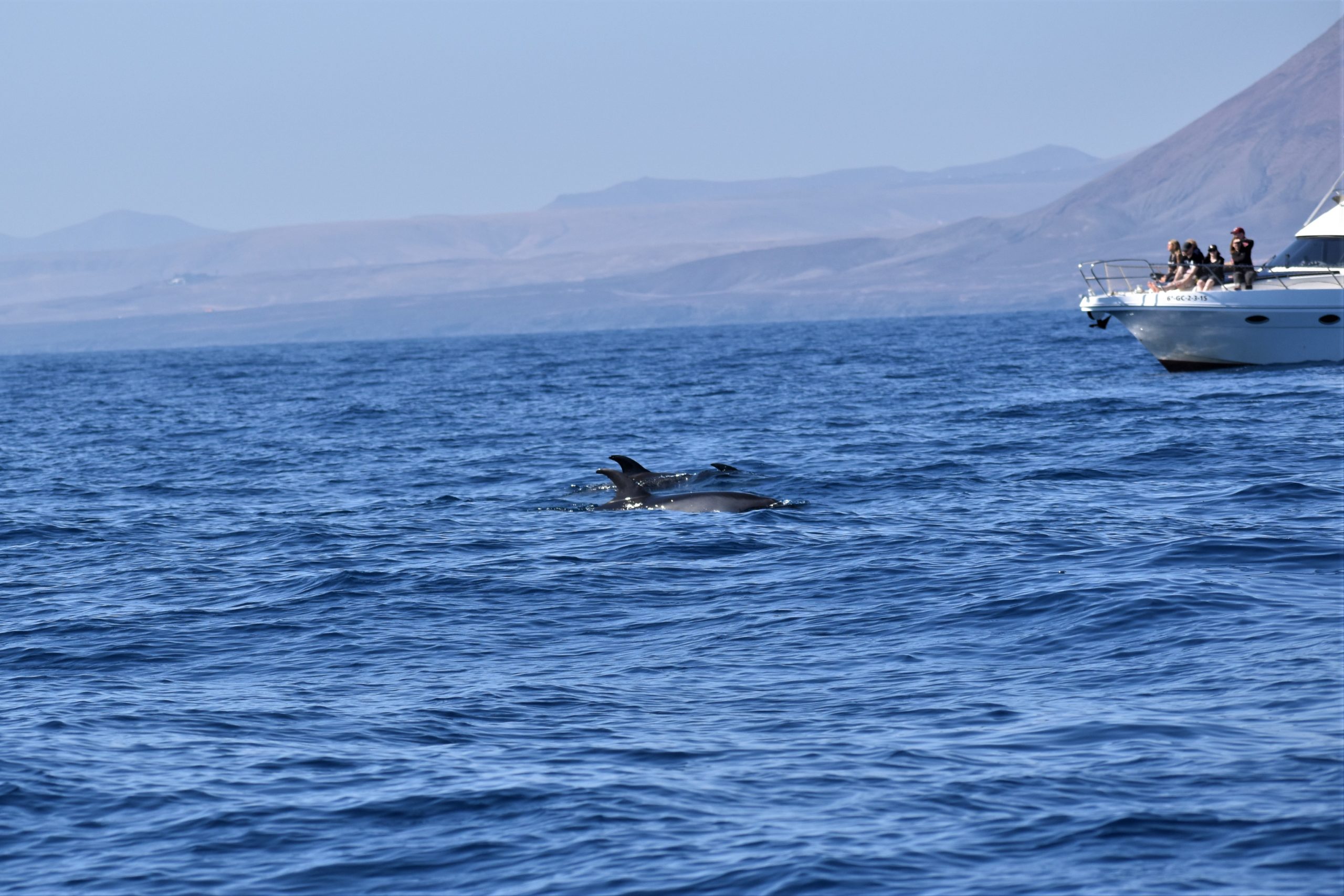
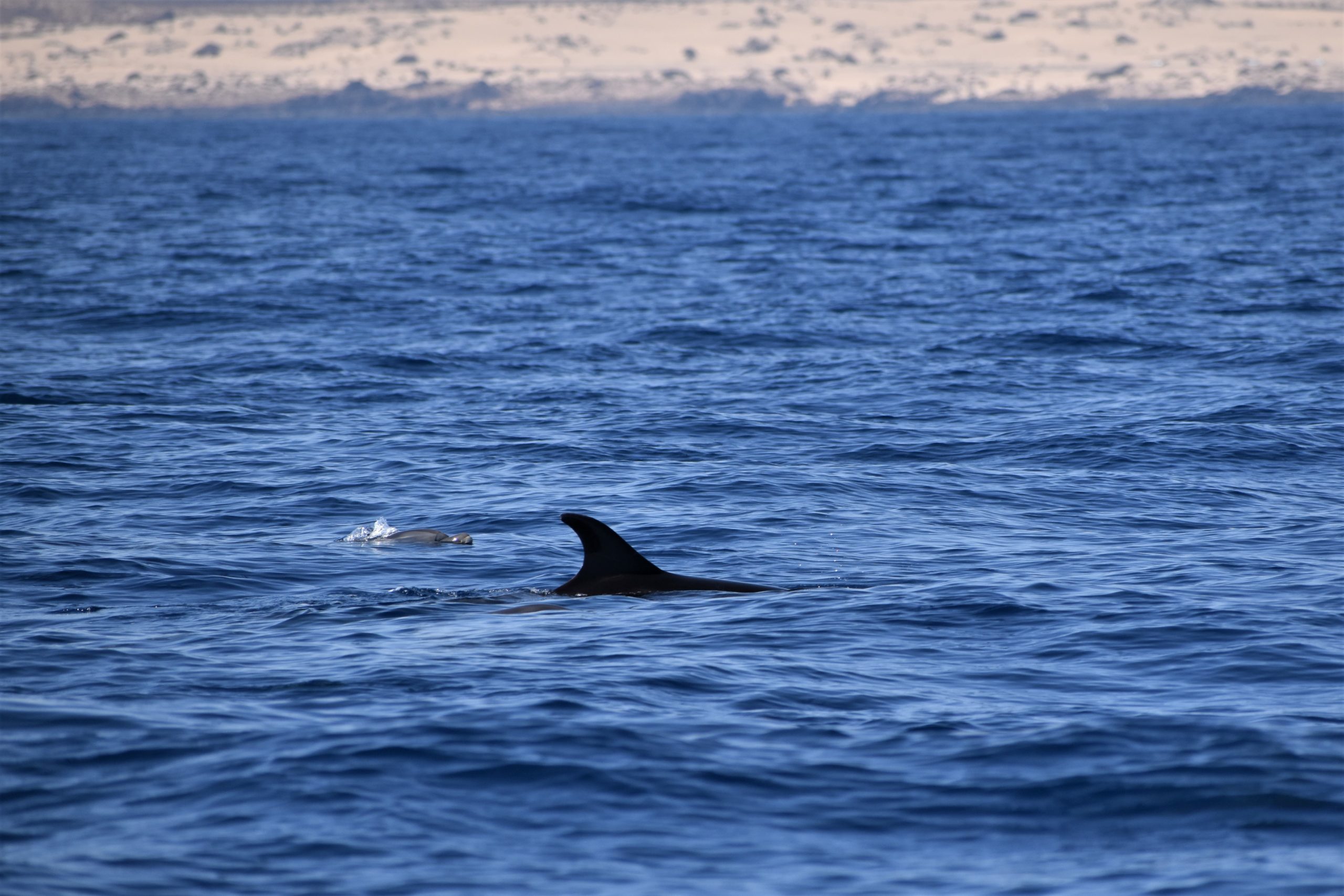

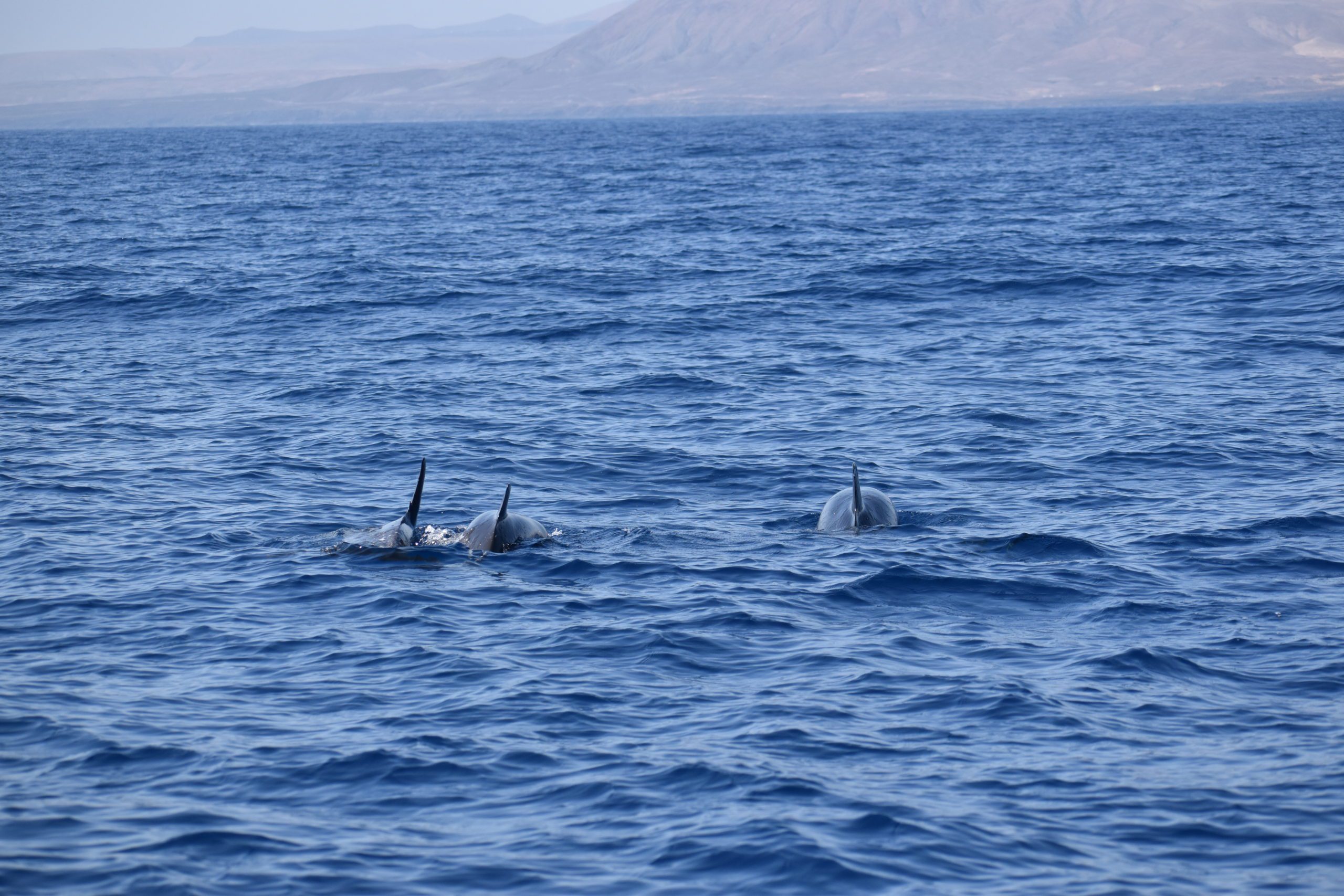
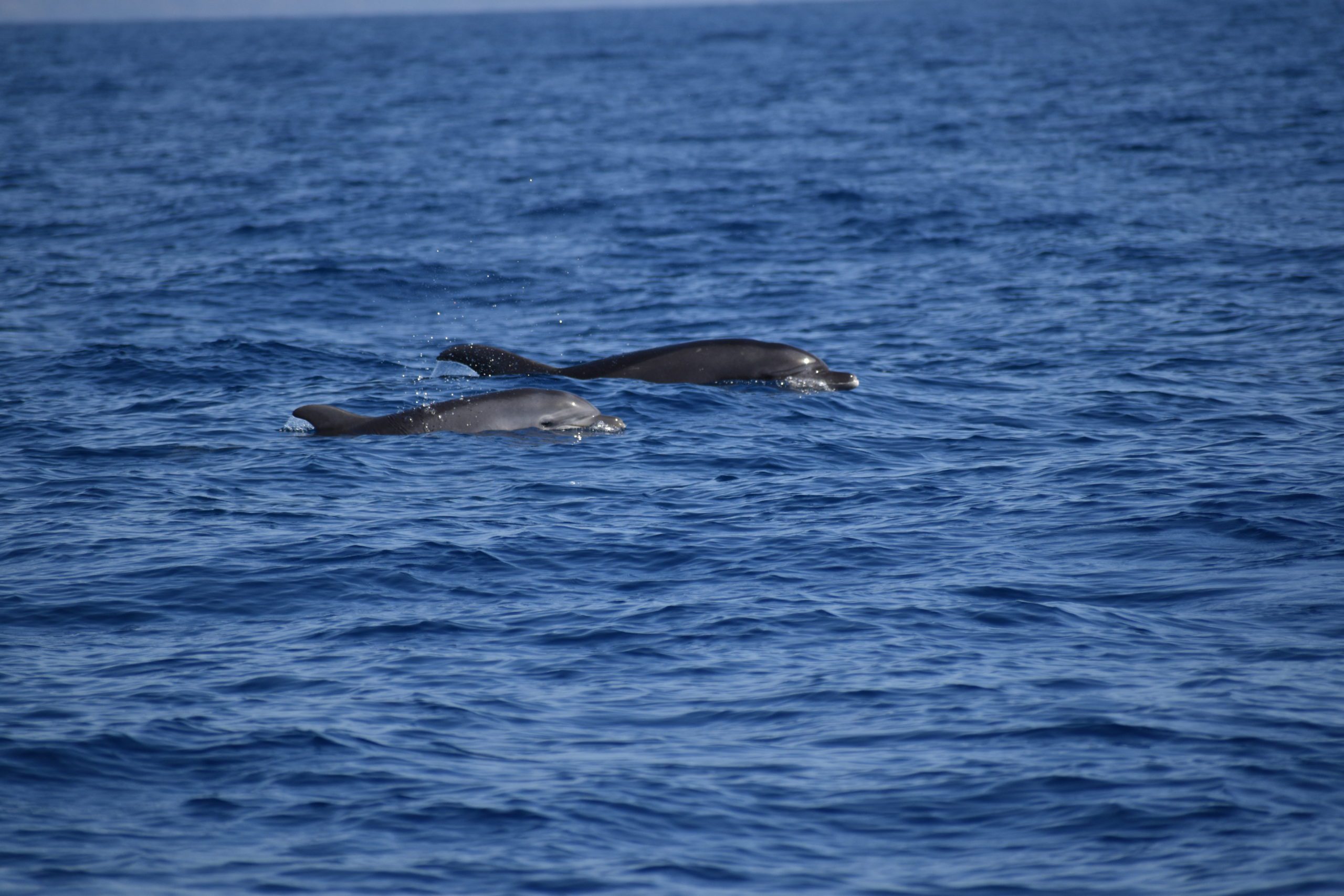
Not far we spot a distinguishable white figure. He’s a lone Risso’s dolphin (Grampus griseus) identified by the white scratch marks over the body. Here’s an interesting scientific study by Mariani et al. 2016 about why they have these markings.
This species is more closely related to pilot and false killer whales than to dolphins. It was great to see this one take a relaxing swim and chuff a few times at the surface.
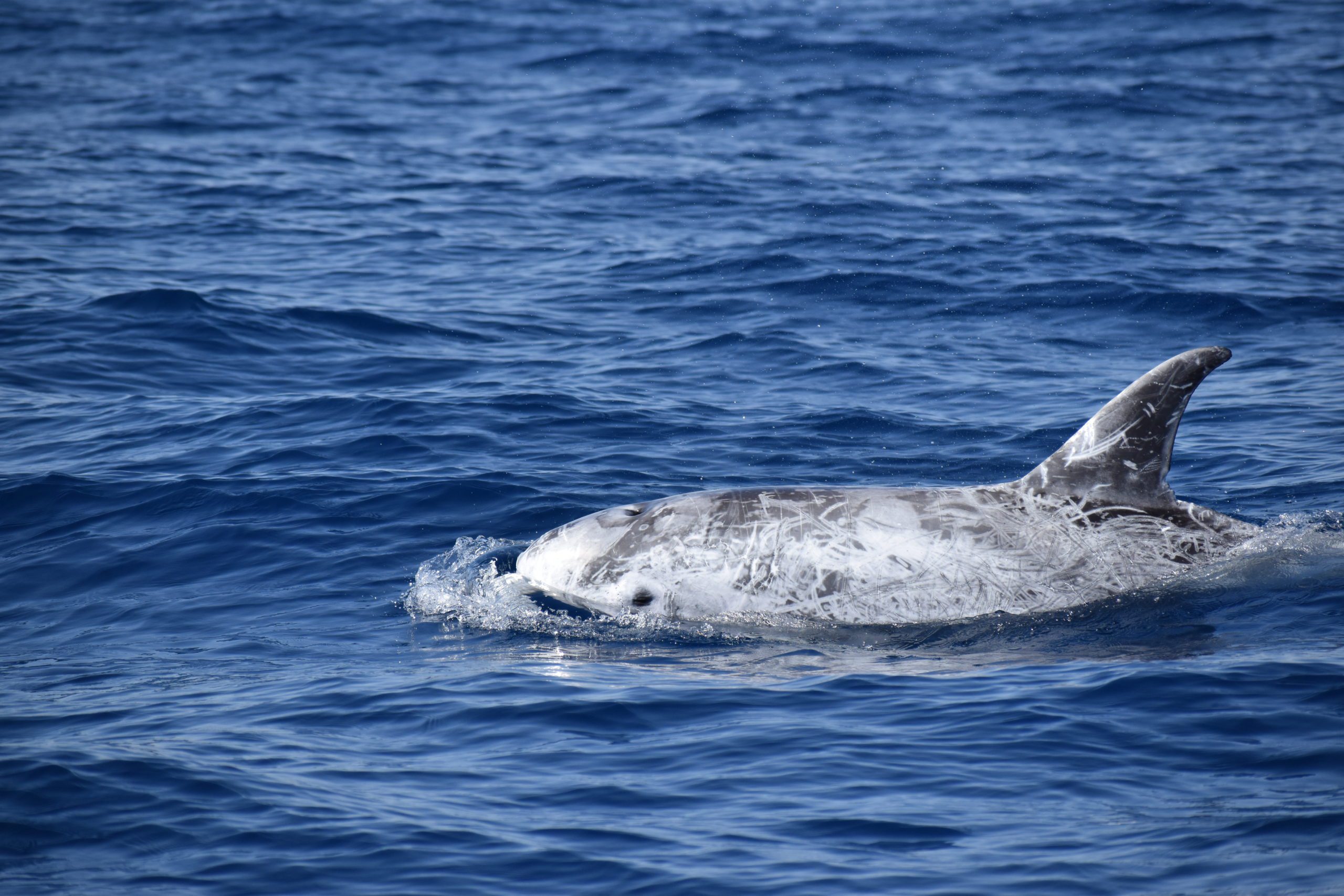
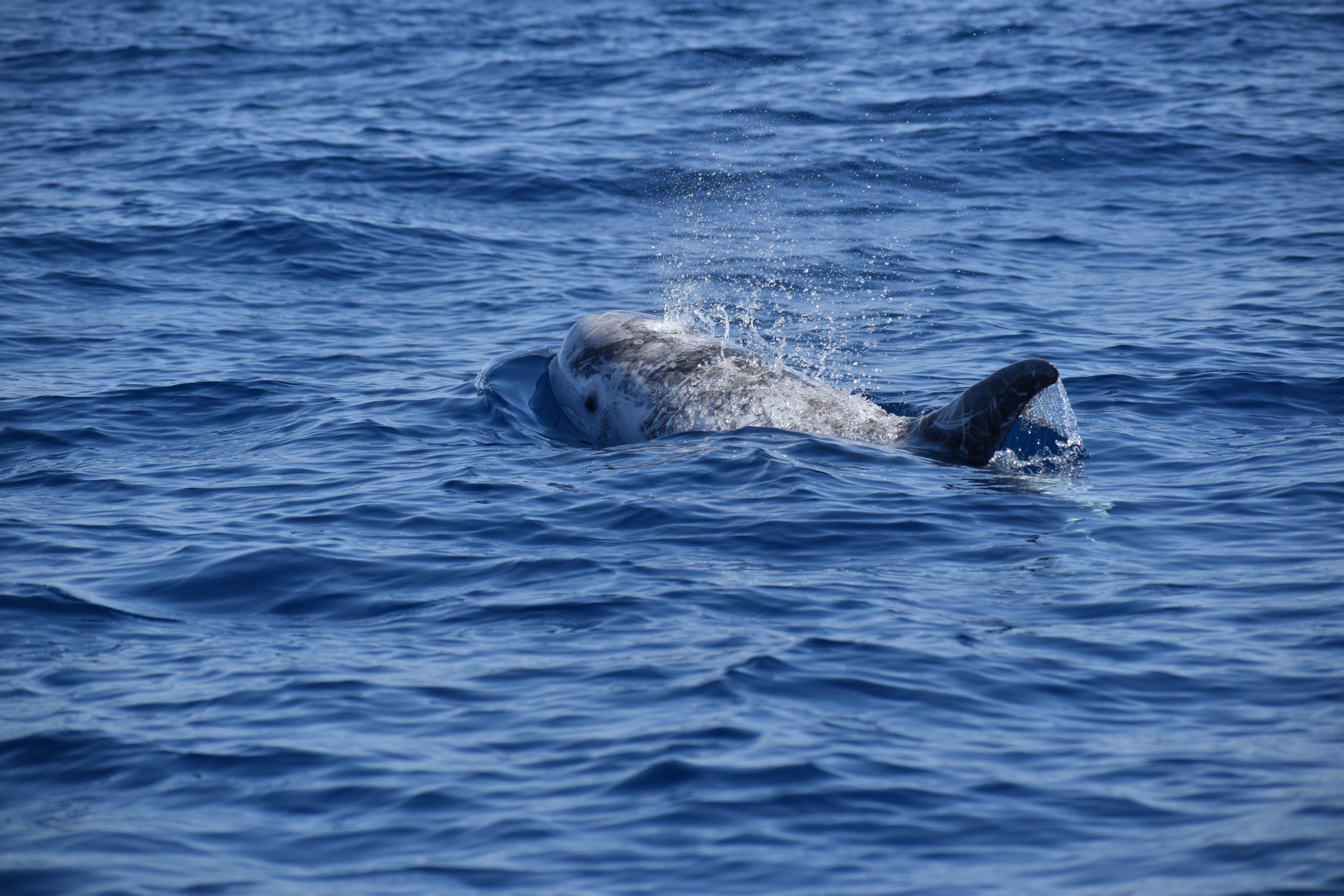
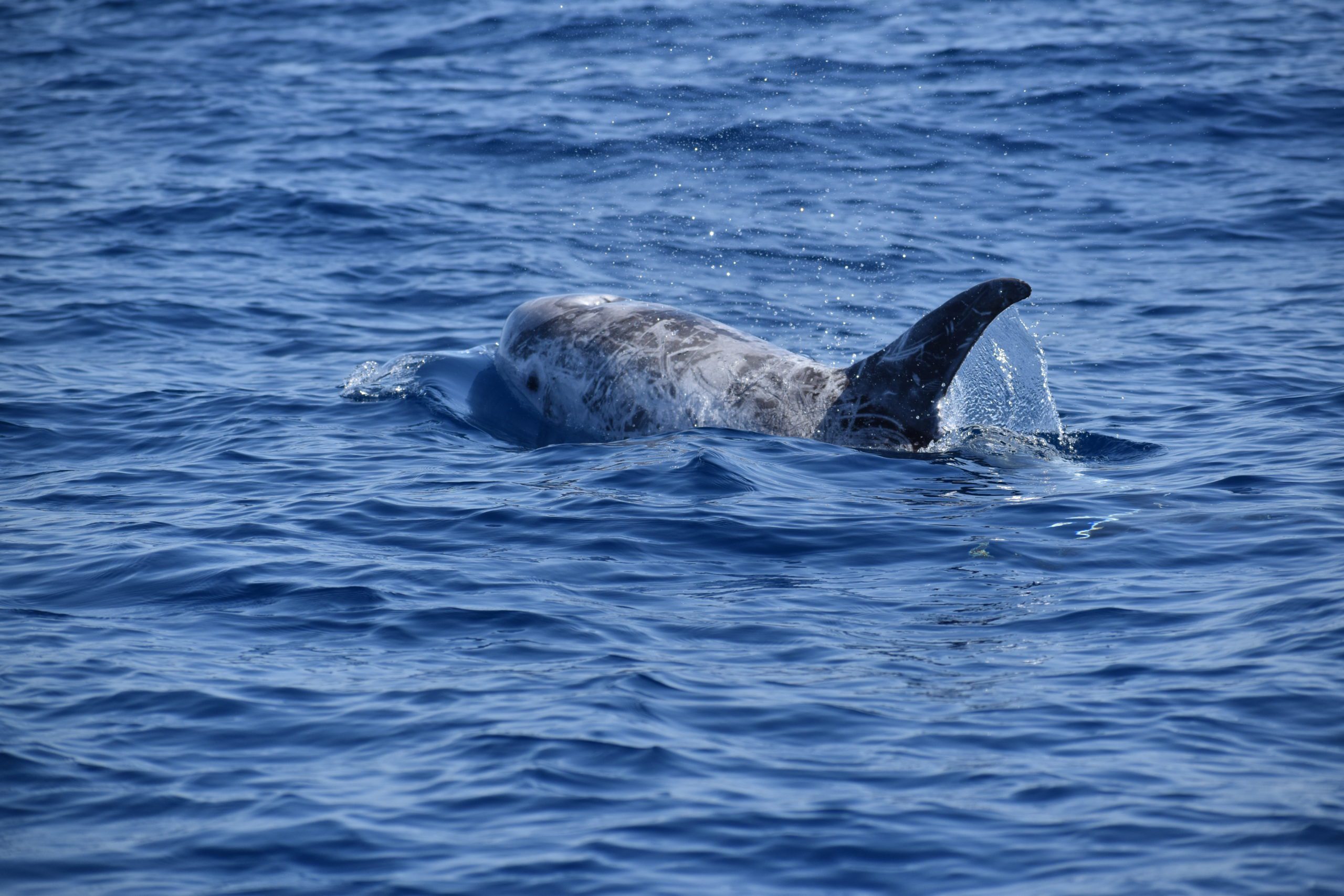
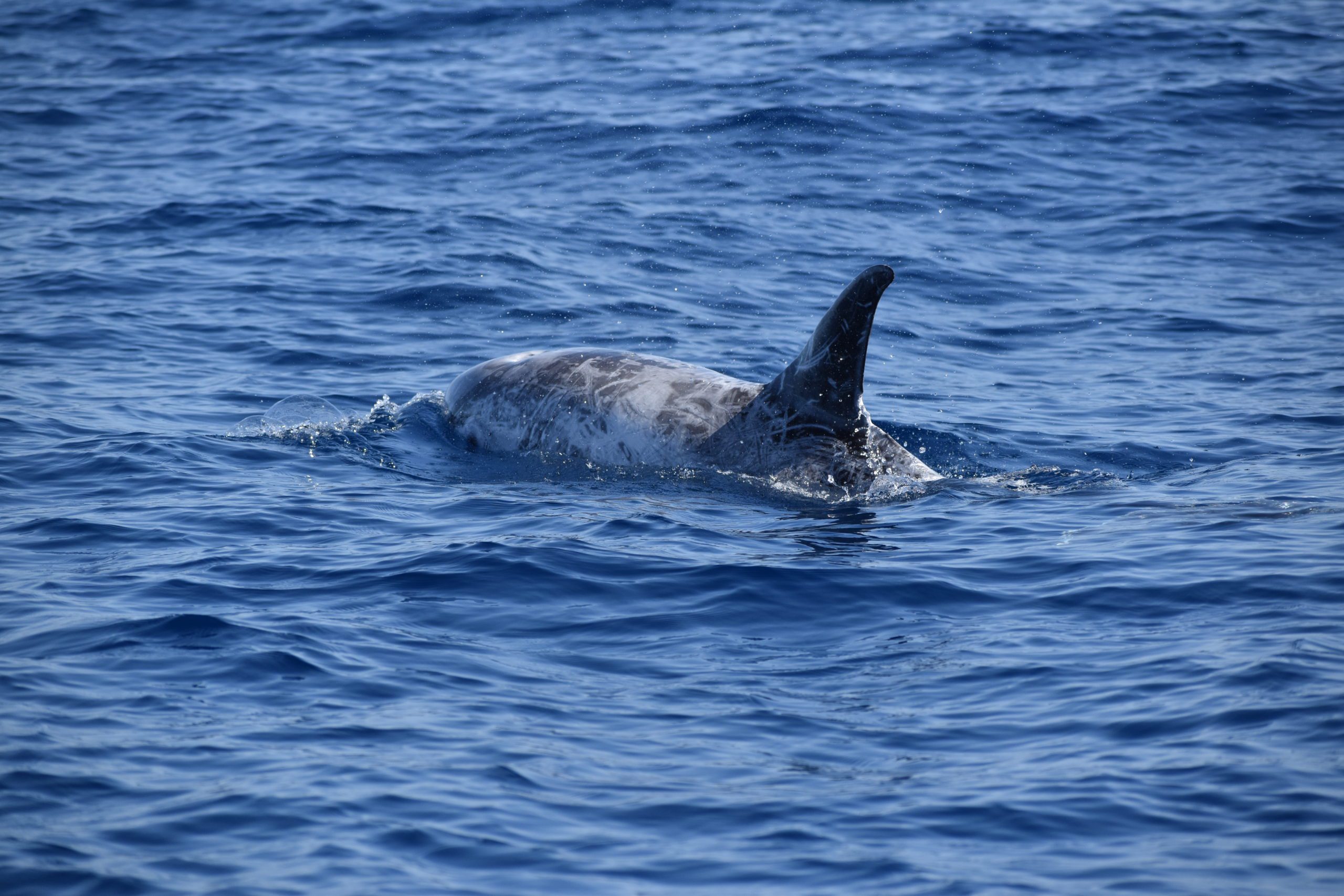

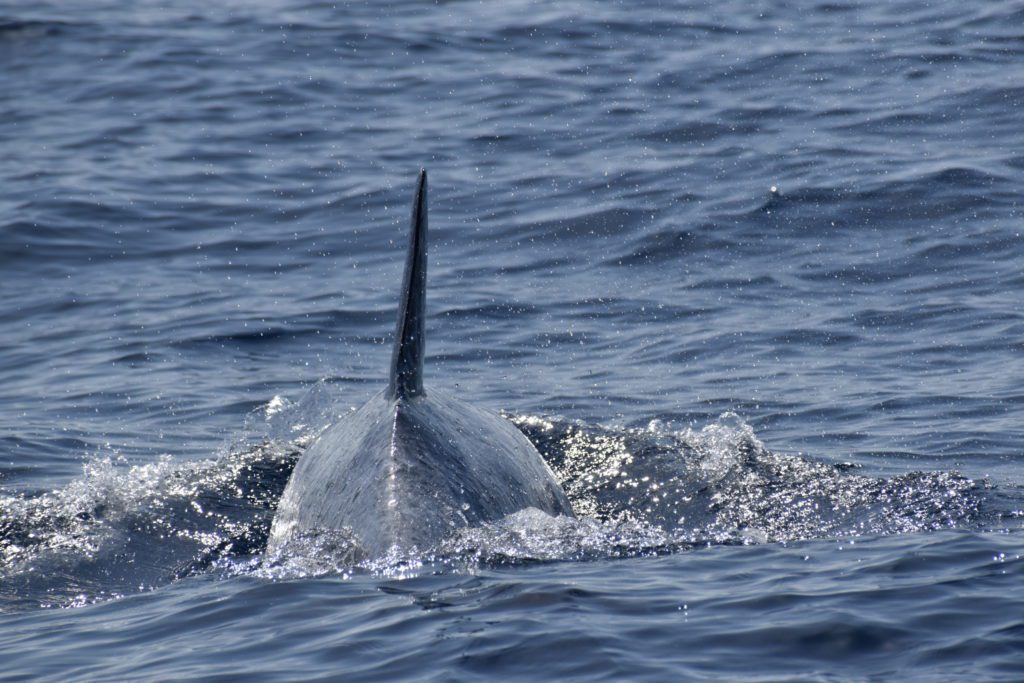
On Board
After things calmed down a bit and all the dolphins went elsewhere, I sat back and checked the time. It had only been about 3 hours on the boat. It felt like a while after all and now after the main show we could just relax and look at the lovely almost turquoise waters near Lobos. We also spotted a loggerhead sea turtle. You can spend the rest of time sunbathing and enjoying the waters on the boat.


A free drink and sandwich was included on board but we had our own snacks and water bottle. You would need to notify them in advance for a vegan option – they take ‘special diet’ requests on booking. Some plastic rubbish floating about in the sea was picked out by the guides. There was one thing missing – the tour said that following this, we would anchor at a ‘heavenly bay’, on a beautiful beach called Playa Concha. This didn’t happen, and I didn’t realize it until the end of the tour being so overjoyed by seeing the dolphins. No one mentioned anything about it either, so I suppose there was some change in the conditions.
End of the tour
Thankfully, everything went according to the guidelines – they didn’t feed the dolphins or force interaction with them. The boat slowed down around them and we spent a good amount of time simply watching them and the guides indeed knew how to go about everything, so we were really happy with the whole tour. We would trust and book a tour with them again.
Below is an affiliate link through which you can book yours, if you would like to have this experience:
CANCO Fuerteventura – Excursions and Sights*

Ethical Dolphin and Whale Watching..
Whale watching following the rules and regulations, is a good way to observe cetaceans in their home. It generates profits through tourism and helps develop a community that appreciates the life of these creatures, as opposed to a one that kills them for profit.
It’s good to note that whaling and hunting dolphins is illegal in most countries at the present time. Japan, Iceland, Greenland, the Faroe Islands and Peru are known to continue these brutal practices. It takes place illegally in other cases. Only when the marine animals start to become endangered, action is taken and now much has been done against the whaling industries.
A significant number of dolphins are also killed by commercial fishing – they are caught as by-catch or used as bait. People don’t realize how destructive fishing is for marine life. It is interesting how people around the world abhor whale killing – a practice that some communities claim to do for survival, ”food” etc. but are completely fine with the modern fish and meat industry, which is much more terrible in terms of numbers for one. Whaling was normalized for ages (still in the places where it is legal) and an organized killing industry as early as 875 AD. It was highly profitable as is the meat industry, not any less barbaric. All we can hope is for this to come to an end soon.
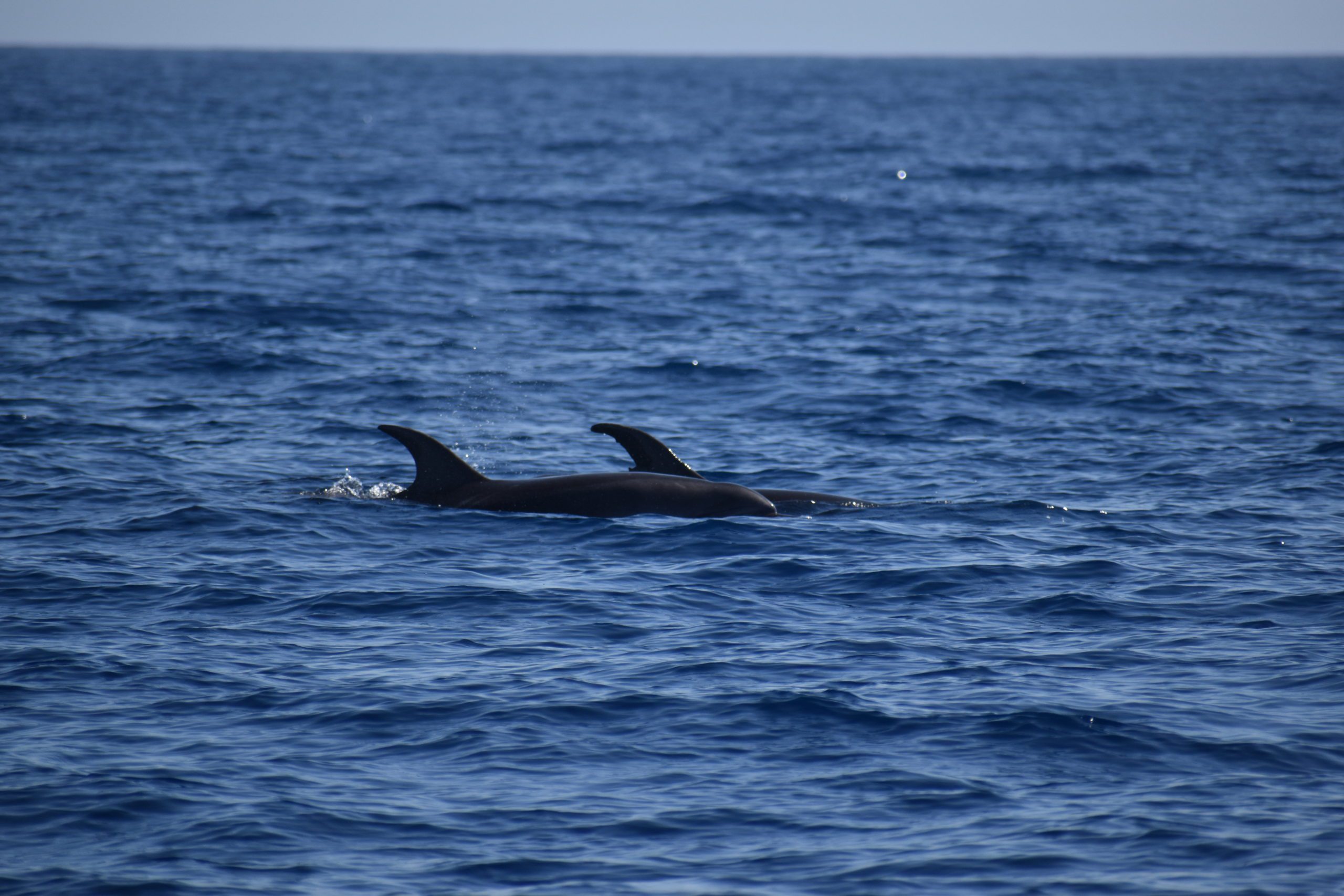
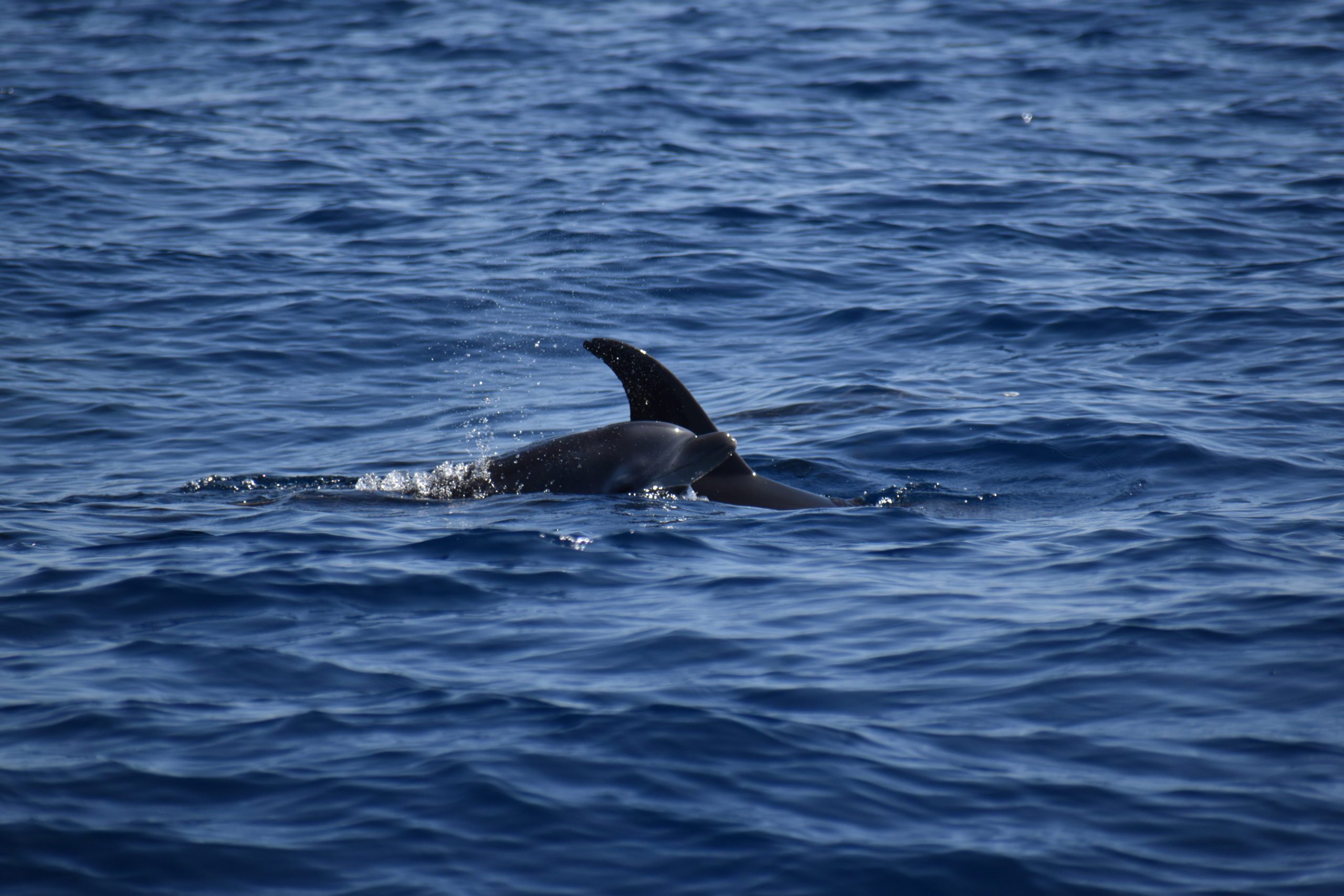
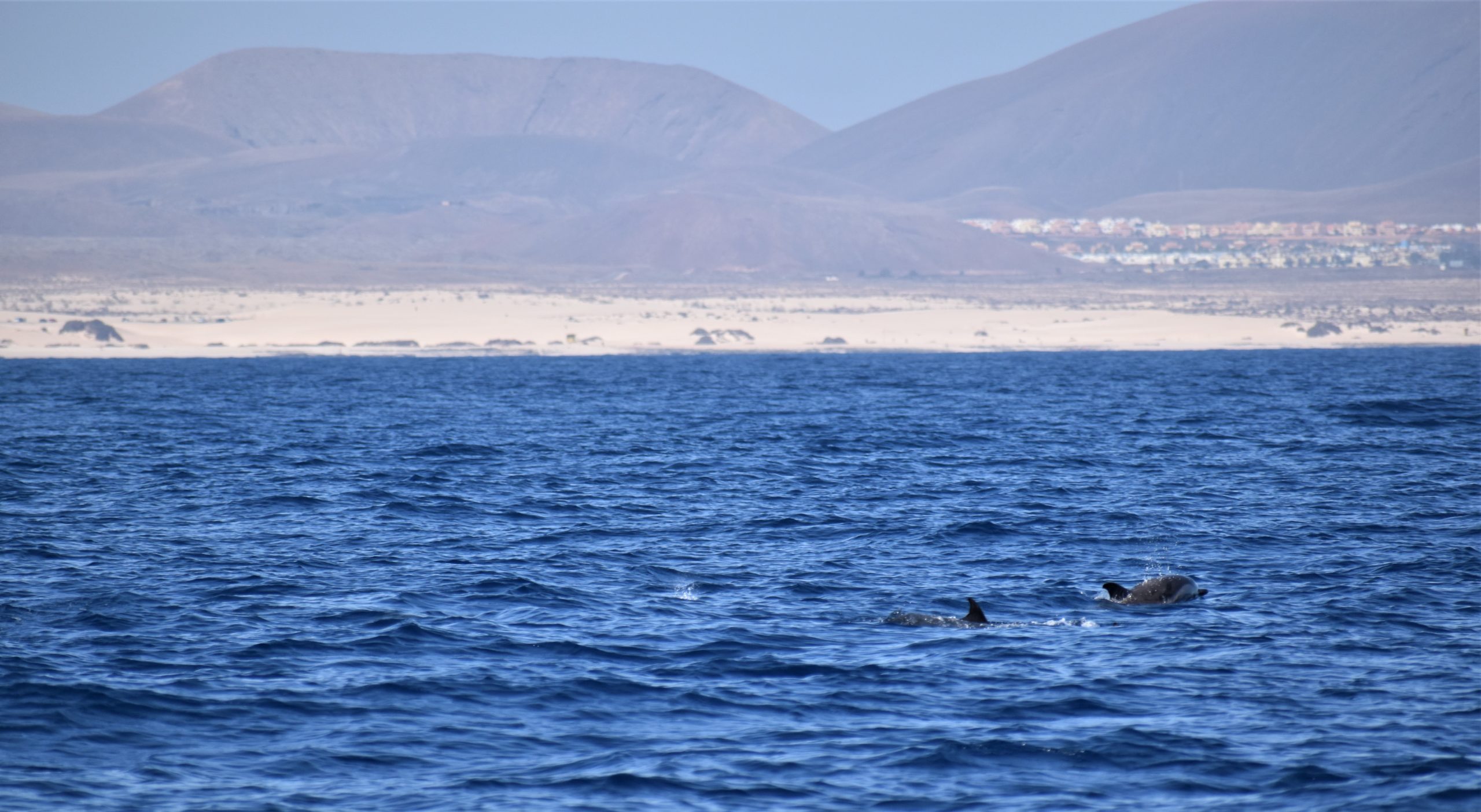
All the photographs in this post are taken by me. Enjoy the gallery and feel free to leave a comment if you would like to say or ask something about the dolphins, photographs or the tour!
*at no extra cost to you, I may earn a small commission if you book a tour through this affiliate link, thanks for your support!

Last updated on May 28th, 2025


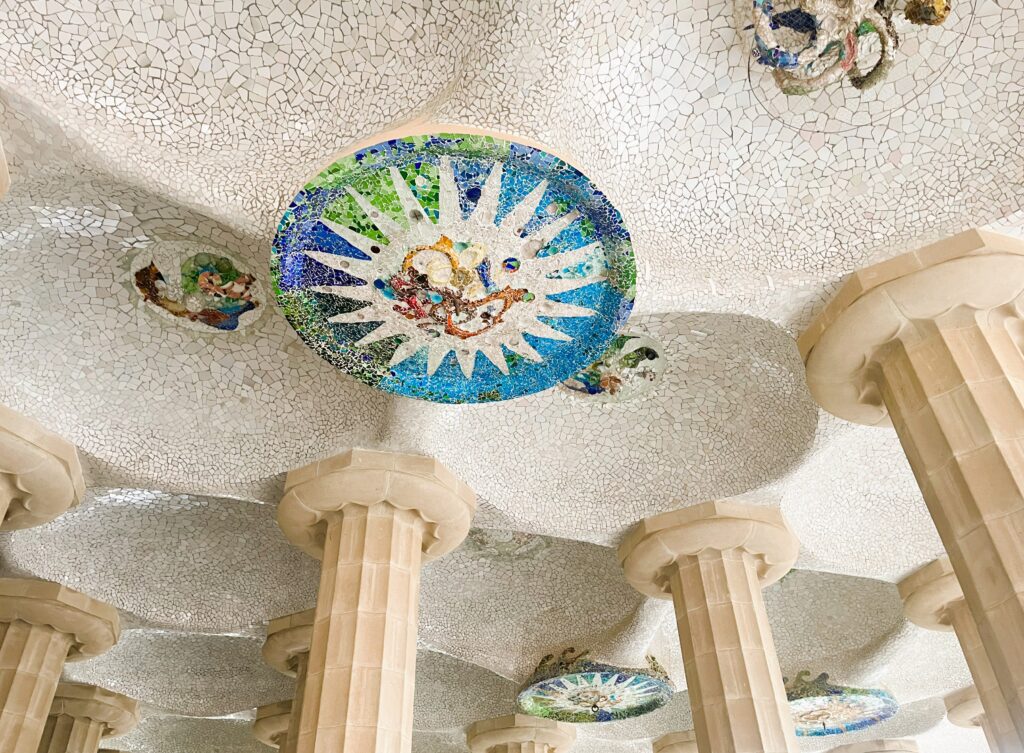


Indeed, we were lucky to see so many of them! Although it’s likely – it’s not guaranteed you will see dolphins/whales on this tour. That’s why I recommend taking the longer tour (5hr) and going during Spring like we did – it greatly increases your chances. You could try land based watching to avoid sea-sickness but you’d need a good pair of binoculars.
VERY LUCK YOU SEEN THEM MY WIFE AND I PAID 90 euro to see the dolphins from caleta de fuste never seen nothing the wife got sea sick WASTE OF TIME AND MONEY no half price next time or free trip next
I went whale watching in 6th grade and still remember it. Being able to see animals in their natural habitat is so magical.
Lovely. I have always liked dolphins. I think it would be amazing to be up close and personal with them!
Laurie
Ridge Haven Homestead
Homestead Blog Hop
Those pics are incredible. You guys must have been completely overloaded with enthusiasm with all of your dolphin sightings 🤩
I really love the markings on the Rosso Dolphin. And I can’t believe the tour was only 75€ For 5hrs! That’s seems like a great price.
Thank you for talking about ethical ways to watch whales and dolphins in their natural habitats 🙌💜🙏
Thanks! I came prepared with camera, (zoom) lens etc. And yes, it was so worth it!
What a beautiful experience! I’ve never seen dolphins in the wild.
You must, it is indeed a beautiful experience! 🙂